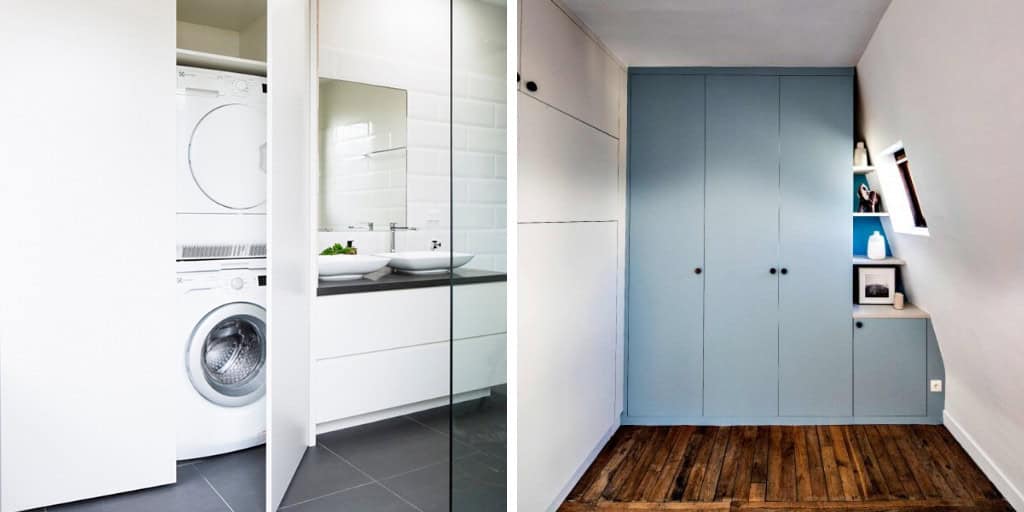It is not necessary to be in a minimalist approach to be interested in the subject. The appearance of this type of furniture is more refined. However, this meets a need for additional storage, which can interest many people. In this article, we will, therefore, see the aesthetic interest of invisible storage; we will also be interested in the rooms and situations in which we generally find this type of layout. And we will also discuss custom-made items which generally meet your requirements better than standard furniture.
WHY INVISIBLE STORAGE IS AN ASSET FOR A MORE REFINED DECORATION?
Very often when we talk to you about decoration and minimalism, emphasizing the fact that aesthetics and functionality are linked, that one cannot think of one without the other. And invisible storage is part of this dynamic. They are practical because you have spaces to store. We will also pay special attention to the appearance of its furniture so that 1 / you like it 2 / they blend completely into your interior.
There is also an idea of simplification. We simplify the appearance of the furniture as much as possible so that it looks more like a wall than a piece of furniture. The idea here, with invisible furniture, is that it blends with a wall, with your decoration. Some nuances allow a piece of furniture to be invisible: the appearance of the facades, the choice of handles, the size of the doors. FFfIn some cases, the piece of furniture seems almost non-existent. We will only see a few facade cutouts. No handle, no hardware, no moldings. Uniformity over a large area will make the storage spaces disappear. A visual illusion like when you try to enlarge a room thanks to the color of the walls and the light.
The simplification of the appearance of the furniture will allow you to put a large amount of furniture without overloading your interior. Fewer details for more storage.

WHERE TO INTEGRATE INVISIBLE STORAGE IN YOUR INTERIOR?
In all the accommodation, there are many possibilities of arrangements and places where you can install invisible furniture that will offer you more storage without physically and visually cluttering your interior:
- Invisible storage under the bed
Put the bed on a platform, raise it to create additional storage in the bedroom - Fitting under the stairs
Fitting under the stairs is often problematic because standard furniture (even those designed for stairs) does not quite match the stairs. When we talk about invisible storage, we come across the limits of the standardization of furniture. - The stair treads for unexpected storage
These spaces can also be fitted out to create invisible storage. Instead of having “empty” steps, we will replace them with drawers. - In the recesses next to the chimney
These are often spaces that are problematic to arrange, lost spaces. - On a complete wall
This solution offers plenty of storage space, which allows you to do without a lot of furniture in the room. It’s like creating a double partition to allow storage. And visually, the result can blend 100% into your decoration. Kitchen, living room, dining room, hallway (if it is wide enough). All the rooms in the house can be furnished with invisible storage. - On a complete wall under the eaves
Like the staircase, the eaves are often problematic to fit out with standard furniture. The difference is that under the eaves when you have a bedroom or an office for example, it is much more difficult to put classic furniture in the room. There are many “lost” spaces under the eaves.

HOW TO USE INVISIBLE STORAGE?
By “how” we will see more the “small” details that differ between conventional storage and invisible storage.
CHOOSE CAREFULLY THE FINISH OF DOORS AND FACADES
The first thing is an aesthetic point. What makes this furniture almost invisible is its appearance. Generally we have doors more than drawers. The drawer will be more an interior arrangement and we will not see it on the front. These doors do not necessarily have a standard size. Take the example of cooking. In a classic kitchen, starting from the floor, there will be a plinth and the front of the low cabinet. This facade generally measures 80 cm. If we want to “fill” a wall with these facades, we will have 3. In the idea of invisibility, even if we have several boxes, we will have a sliding door or two hinged doors to make it more discreet.
The finish is also the materials used, the shape of these materials, the details of hardware … The handles will be discreet or even completely invisible. The hinges will also be invisible. Fewer details, more invisibility. For materials, it’s a story of taste. We will find invisible painted furniture. The lacquer is shiny and easy to clean, in a kitchen, it can be interesting. As for the mat, it reinforces the feeling of invisibility but in terms of cleaning, that’s not it. There will be more invisible matt storage in a living room for example. We can also think of wood which gives a very warm side to a room especially if it is used in large quantities.

*

*


